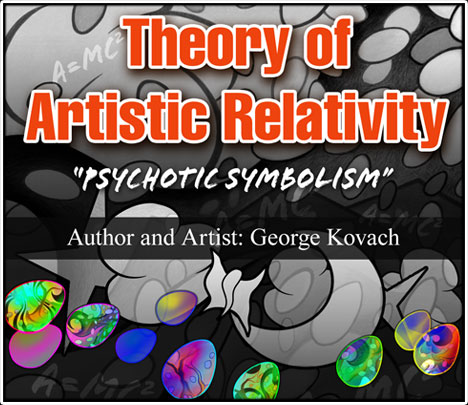
- Introduction:
Explanation Of Content - Section One:
Elaborated Version Of "The Theory Of Artistic Relativity". - Section Two:
Elaborated Version Of The Theory's First Derivational Category Of Art, "Psychotic Symbolism". - Section Three:
"Let Us Not Forget!" - The "Artistic Tragedy" Of A Great Artist. - Section Four:
Condensed Version Of The Theory And Category As Copyrighted In 1985. - Section Five:
The Symbolism Of "The Moth"
5. Section Four:
Condensed Version Of The Theory And Category As Copyrighted In 1985.
Jump to: Prelude | Part 1 | Part 2 | Psychotic Episodes
PRELUDE
"The Theory of Artistic Relativity" is an attempt to analyze and describe the transgression of the artworld for the purpose of constructing a simplified functional base from which new artistic endeavors can be created. The theory exposes the course of artistic transgression in order to structuralize the process of creativity into artistic formula. The theory's implications reverses the course of artistic transgression back into the artworld's developmental stages, establishing a cyclical patterned body of reference for the creation of new works of art. It is intended to help preserve the artworld's identity and help prevent it's selfdestruction through lack of controlling attitudes by establishing guidelines that offer to the artistic realm a systematic form of execution for speculatory design purposes.
"Psychotic Symbolism" is the first category of art derived from the formulaic implications of "The Theory of Artistic Relativity." It is the first category of art designed according to the idea of artistic transgression reversing. The artistic chemistry of "Psychotic Symbolism" is a calculatory process of execution of creativity in itself, which can be an example for the expansion of creative development for current artwork now being executed. The analysis of "Psychotic Symbolism" and the concept of its categorical derivation from "The Theory of Artistic Relativity" can, in the least, offer a superficial viewpoint for the direction of new artistic transgression ascertained from common artistic logic.



